University Resource Efficient Design Report: Process and Interventions
VerifiedAdded on 2023/01/16
|10
|3140
|57
Report
AI Summary
This report provides a comprehensive analysis of resource-efficient design, focusing on the process life cycle and interventions to minimize the use of natural resources and energy consumption, as well as the reduction of waste generated during production. The report begins with an introduction to resource-efficient design principles, followed by an overview of resource considerations within the product development process. The main body delves into specific interventions to minimize resource use, such as material selection, cleaner production techniques, and waste management strategies. It also explores the importance of recycling, dematerialization, and closed-loop design systems. The report concludes with design recommendations aimed at improving efficiency and performance. The report emphasizes the importance of sustainable practices and provides practical insights for businesses and organizations seeking to optimize their resource usage and minimize their environmental impact, supporting sustainable design and manufacturing practices. The report also highlights that the use of natural resources has led to the development of innovative and commercially successful replacement products.
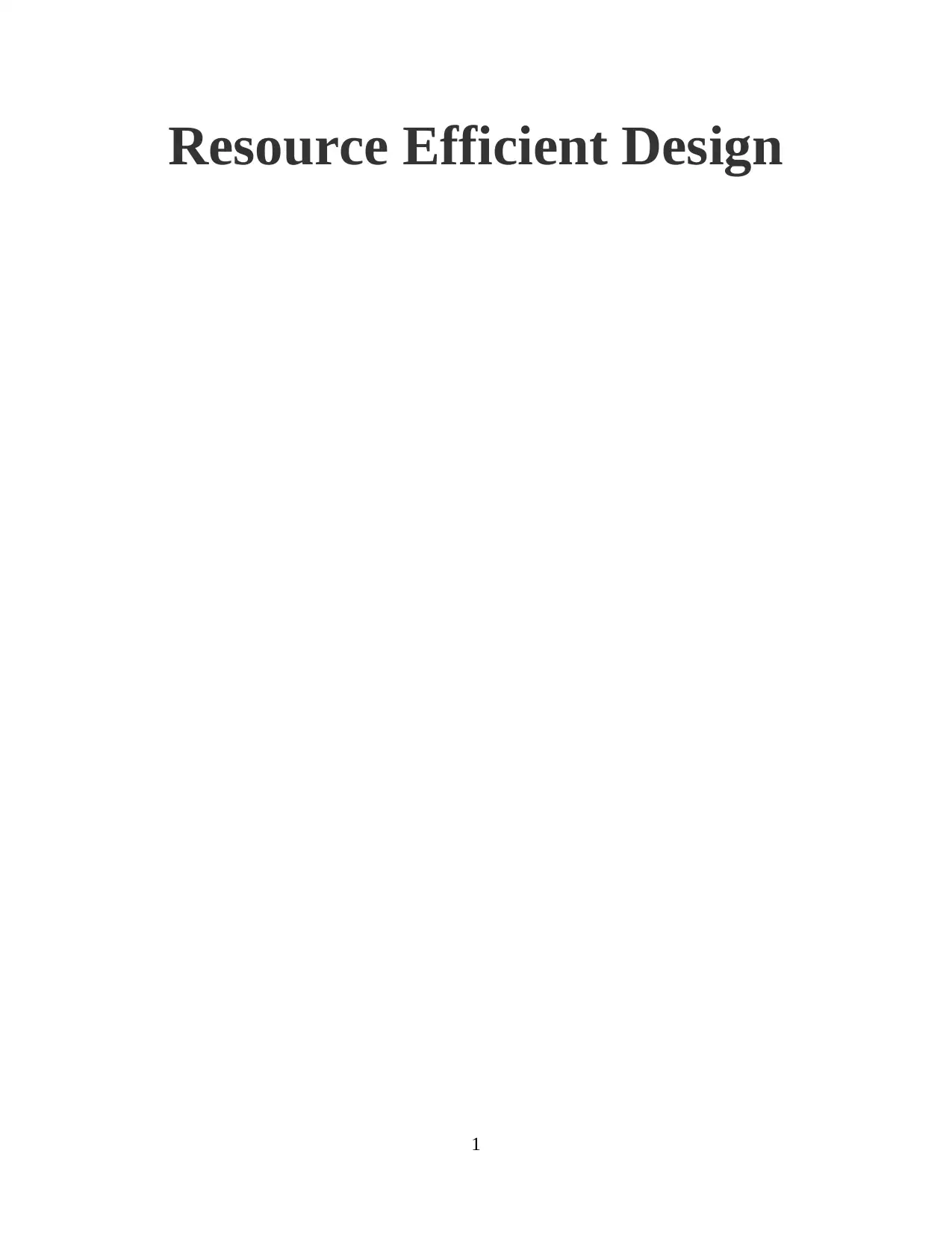
Resource Efficient Design
1
1
Paraphrase This Document
Need a fresh take? Get an instant paraphrase of this document with our AI Paraphraser

Contents
INTRODUCTION...........................................................................................................................3
MAIN BODY..................................................................................................................................3
Overview of resource considerations within process life cycle...................................................3
Describe the range of interventions that will minimize use of natural resources, energy level of
waste generated in production process........................................................................................5
Summarise set of design recommendations.................................................................................8
CONCLUSION................................................................................................................................9
2
INTRODUCTION...........................................................................................................................3
MAIN BODY..................................................................................................................................3
Overview of resource considerations within process life cycle...................................................3
Describe the range of interventions that will minimize use of natural resources, energy level of
waste generated in production process........................................................................................5
Summarise set of design recommendations.................................................................................8
CONCLUSION................................................................................................................................9
2

INTRODUCTION
Resource efficient design is a type of process that use in supply of material, staff members
and other type of assets which drawn on by organization. In order to perform function effectively
and efficiently with reduce waste resource expenses. In this report, it will describe about the
resources considerations that mainly used in the product development as well as design. It will
choose the production process that help for reducing wastage. Furthermore, it will evaluate the
production process that outline set of design recommendation for improving efficiency and
performance. However, the report will describe about various type of resources that useful in
process life cycle while analyse wide range of interventions for minimizing the use of natural
resources, energy level of waste generated in production process.
MAIN BODY
Overview of resource considerations within process life cycle
Resources are typically used to produce the efficient product and design the process for
improving efficiency as well as performance. It mainly deals with the resource policy which
accomplish an eco-deign understanding the overall consequences of resources usage if it
required. The flow of resources on earth is very large because in context of production process
material flow analyses that means to be generated or produced the product. The resources have
not equally distributed over earth. The industrial nations use more natural resources for
developing nations. In this way, it has increased the risk for industries to minimize level of
resources drastically. In fact, it is also possible to calculate that if natural resource use in the
entire world. it automatically decreases by different factors. The most of resources are required
for making an item exits on limited scale which may applies to put input goods and other type of
raw material, especially those are not renewable.
In context of internationally, water is also limited resources while energy has not required
limited resources. Aluminium usage is to be reduced due to large emission of greenhouse gases
from the product production. It can be reused for electricity. Sometimes, it may also consider as
a limited resource which may utilise an appropriate amount of water that are utilised to produce
them. These are used in end of process life cycle. For manufacturing electric vehicle or car, it is
largely used the natural resource like reusable aluminium raw material. It is likely to dominate
the flow of world’s energy so that total depletion of use which seems remote. In this way, it also
increases the level of carbon dioxide in the atmosphere because of oil and gas. Nowadays, this
3
Resource efficient design is a type of process that use in supply of material, staff members
and other type of assets which drawn on by organization. In order to perform function effectively
and efficiently with reduce waste resource expenses. In this report, it will describe about the
resources considerations that mainly used in the product development as well as design. It will
choose the production process that help for reducing wastage. Furthermore, it will evaluate the
production process that outline set of design recommendation for improving efficiency and
performance. However, the report will describe about various type of resources that useful in
process life cycle while analyse wide range of interventions for minimizing the use of natural
resources, energy level of waste generated in production process.
MAIN BODY
Overview of resource considerations within process life cycle
Resources are typically used to produce the efficient product and design the process for
improving efficiency as well as performance. It mainly deals with the resource policy which
accomplish an eco-deign understanding the overall consequences of resources usage if it
required. The flow of resources on earth is very large because in context of production process
material flow analyses that means to be generated or produced the product. The resources have
not equally distributed over earth. The industrial nations use more natural resources for
developing nations. In this way, it has increased the risk for industries to minimize level of
resources drastically. In fact, it is also possible to calculate that if natural resource use in the
entire world. it automatically decreases by different factors. The most of resources are required
for making an item exits on limited scale which may applies to put input goods and other type of
raw material, especially those are not renewable.
In context of internationally, water is also limited resources while energy has not required
limited resources. Aluminium usage is to be reduced due to large emission of greenhouse gases
from the product production. It can be reused for electricity. Sometimes, it may also consider as
a limited resource which may utilise an appropriate amount of water that are utilised to produce
them. These are used in end of process life cycle. For manufacturing electric vehicle or car, it is
largely used the natural resource like reusable aluminium raw material. It is likely to dominate
the flow of world’s energy so that total depletion of use which seems remote. In this way, it also
increases the level of carbon dioxide in the atmosphere because of oil and gas. Nowadays, this
3
⊘ This is a preview!⊘
Do you want full access?
Subscribe today to unlock all pages.

Trusted by 1+ million students worldwide
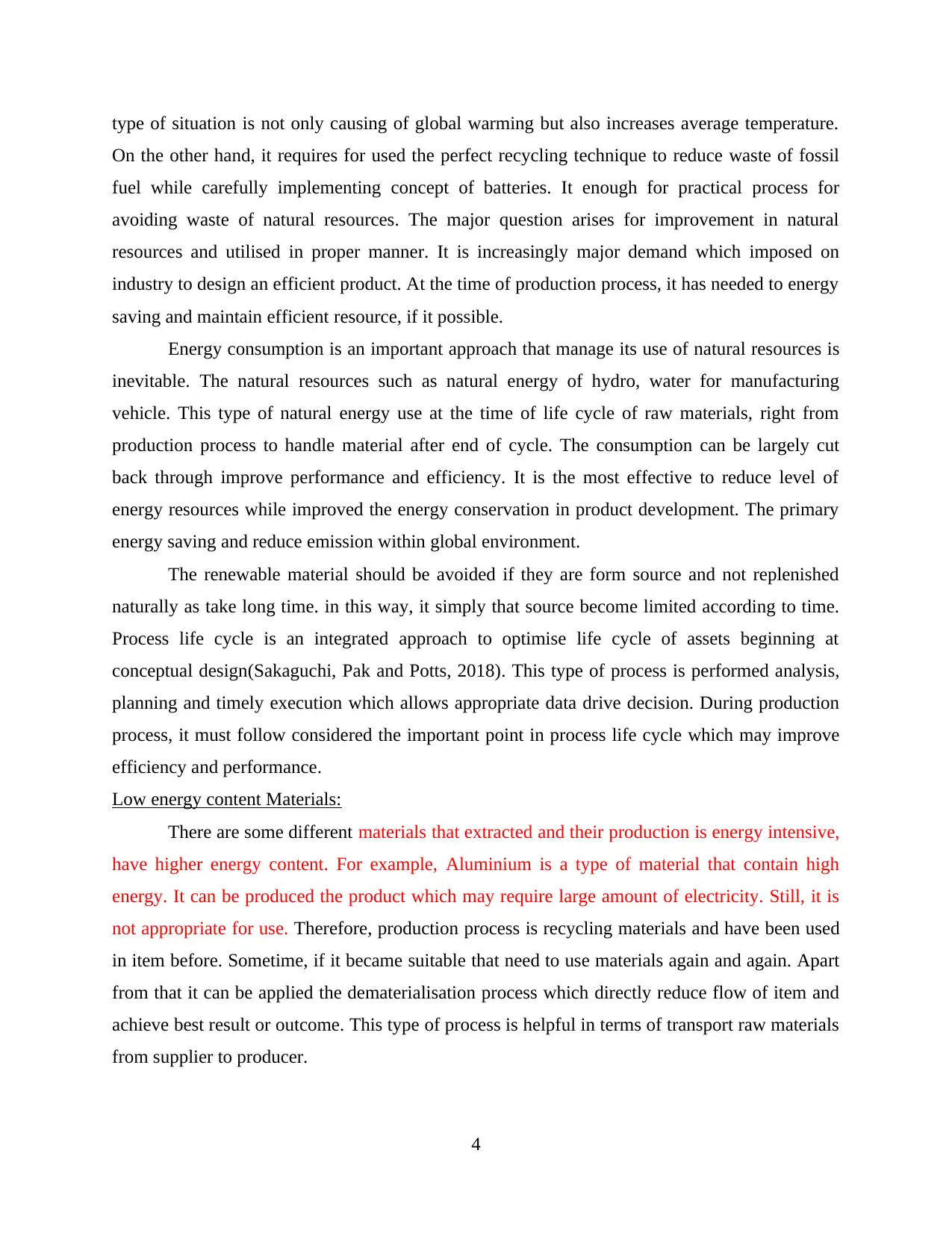
type of situation is not only causing of global warming but also increases average temperature.
On the other hand, it requires for used the perfect recycling technique to reduce waste of fossil
fuel while carefully implementing concept of batteries. It enough for practical process for
avoiding waste of natural resources. The major question arises for improvement in natural
resources and utilised in proper manner. It is increasingly major demand which imposed on
industry to design an efficient product. At the time of production process, it has needed to energy
saving and maintain efficient resource, if it possible.
Energy consumption is an important approach that manage its use of natural resources is
inevitable. The natural resources such as natural energy of hydro, water for manufacturing
vehicle. This type of natural energy use at the time of life cycle of raw materials, right from
production process to handle material after end of cycle. The consumption can be largely cut
back through improve performance and efficiency. It is the most effective to reduce level of
energy resources while improved the energy conservation in product development. The primary
energy saving and reduce emission within global environment.
The renewable material should be avoided if they are form source and not replenished
naturally as take long time. in this way, it simply that source become limited according to time.
Process life cycle is an integrated approach to optimise life cycle of assets beginning at
conceptual design(Sakaguchi, Pak and Potts, 2018). This type of process is performed analysis,
planning and timely execution which allows appropriate data drive decision. During production
process, it must follow considered the important point in process life cycle which may improve
efficiency and performance.
Low energy content Materials:
There are some different materials that extracted and their production is energy intensive,
have higher energy content. For example, Aluminium is a type of material that contain high
energy. It can be produced the product which may require large amount of electricity. Still, it is
not appropriate for use. Therefore, production process is recycling materials and have been used
in item before. Sometime, if it became suitable that need to use materials again and again. Apart
from that it can be applied the dematerialisation process which directly reduce flow of item and
achieve best result or outcome. This type of process is helpful in terms of transport raw materials
from supplier to producer.
4
On the other hand, it requires for used the perfect recycling technique to reduce waste of fossil
fuel while carefully implementing concept of batteries. It enough for practical process for
avoiding waste of natural resources. The major question arises for improvement in natural
resources and utilised in proper manner. It is increasingly major demand which imposed on
industry to design an efficient product. At the time of production process, it has needed to energy
saving and maintain efficient resource, if it possible.
Energy consumption is an important approach that manage its use of natural resources is
inevitable. The natural resources such as natural energy of hydro, water for manufacturing
vehicle. This type of natural energy use at the time of life cycle of raw materials, right from
production process to handle material after end of cycle. The consumption can be largely cut
back through improve performance and efficiency. It is the most effective to reduce level of
energy resources while improved the energy conservation in product development. The primary
energy saving and reduce emission within global environment.
The renewable material should be avoided if they are form source and not replenished
naturally as take long time. in this way, it simply that source become limited according to time.
Process life cycle is an integrated approach to optimise life cycle of assets beginning at
conceptual design(Sakaguchi, Pak and Potts, 2018). This type of process is performed analysis,
planning and timely execution which allows appropriate data drive decision. During production
process, it must follow considered the important point in process life cycle which may improve
efficiency and performance.
Low energy content Materials:
There are some different materials that extracted and their production is energy intensive,
have higher energy content. For example, Aluminium is a type of material that contain high
energy. It can be produced the product which may require large amount of electricity. Still, it is
not appropriate for use. Therefore, production process is recycling materials and have been used
in item before. Sometime, if it became suitable that need to use materials again and again. Apart
from that it can be applied the dematerialisation process which directly reduce flow of item and
achieve best result or outcome. This type of process is helpful in terms of transport raw materials
from supplier to producer.
4
Paraphrase This Document
Need a fresh take? Get an instant paraphrase of this document with our AI Paraphraser
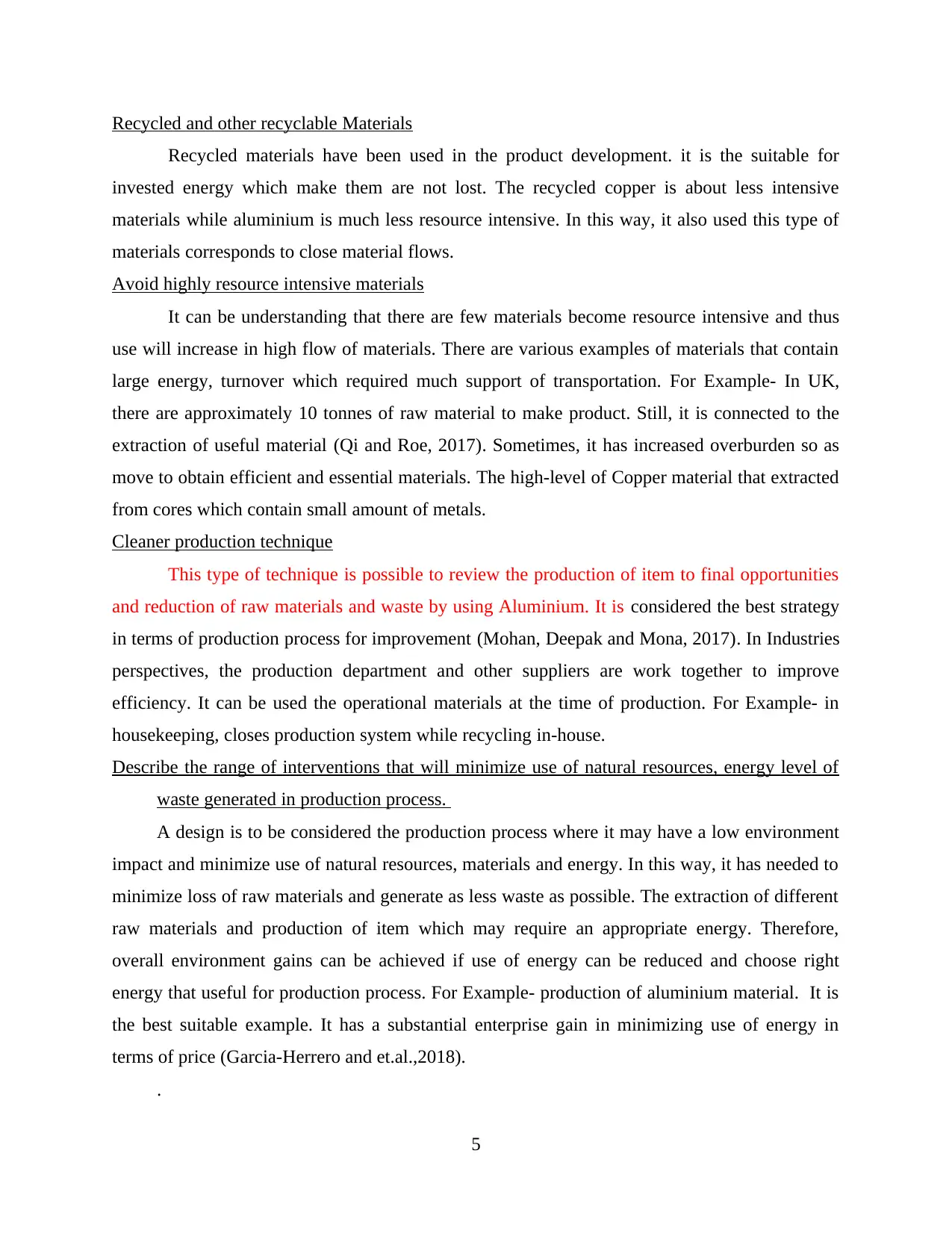
Recycled and other recyclable Materials
Recycled materials have been used in the product development. it is the suitable for
invested energy which make them are not lost. The recycled copper is about less intensive
materials while aluminium is much less resource intensive. In this way, it also used this type of
materials corresponds to close material flows.
Avoid highly resource intensive materials
It can be understanding that there are few materials become resource intensive and thus
use will increase in high flow of materials. There are various examples of materials that contain
large energy, turnover which required much support of transportation. For Example- In UK,
there are approximately 10 tonnes of raw material to make product. Still, it is connected to the
extraction of useful material (Qi and Roe, 2017). Sometimes, it has increased overburden so as
move to obtain efficient and essential materials. The high-level of Copper material that extracted
from cores which contain small amount of metals.
Cleaner production technique
This type of technique is possible to review the production of item to final opportunities
and reduction of raw materials and waste by using Aluminium. It is considered the best strategy
in terms of production process for improvement (Mohan, Deepak and Mona, 2017). In Industries
perspectives, the production department and other suppliers are work together to improve
efficiency. It can be used the operational materials at the time of production. For Example- in
housekeeping, closes production system while recycling in-house.
Describe the range of interventions that will minimize use of natural resources, energy level of
waste generated in production process.
A design is to be considered the production process where it may have a low environment
impact and minimize use of natural resources, materials and energy. In this way, it has needed to
minimize loss of raw materials and generate as less waste as possible. The extraction of different
raw materials and production of item which may require an appropriate energy. Therefore,
overall environment gains can be achieved if use of energy can be reduced and choose right
energy that useful for production process. For Example- production of aluminium material. It is
the best suitable example. It has a substantial enterprise gain in minimizing use of energy in
terms of price (Garcia-Herrero and et.al.,2018).
.
5
Recycled materials have been used in the product development. it is the suitable for
invested energy which make them are not lost. The recycled copper is about less intensive
materials while aluminium is much less resource intensive. In this way, it also used this type of
materials corresponds to close material flows.
Avoid highly resource intensive materials
It can be understanding that there are few materials become resource intensive and thus
use will increase in high flow of materials. There are various examples of materials that contain
large energy, turnover which required much support of transportation. For Example- In UK,
there are approximately 10 tonnes of raw material to make product. Still, it is connected to the
extraction of useful material (Qi and Roe, 2017). Sometimes, it has increased overburden so as
move to obtain efficient and essential materials. The high-level of Copper material that extracted
from cores which contain small amount of metals.
Cleaner production technique
This type of technique is possible to review the production of item to final opportunities
and reduction of raw materials and waste by using Aluminium. It is considered the best strategy
in terms of production process for improvement (Mohan, Deepak and Mona, 2017). In Industries
perspectives, the production department and other suppliers are work together to improve
efficiency. It can be used the operational materials at the time of production. For Example- in
housekeeping, closes production system while recycling in-house.
Describe the range of interventions that will minimize use of natural resources, energy level of
waste generated in production process.
A design is to be considered the production process where it may have a low environment
impact and minimize use of natural resources, materials and energy. In this way, it has needed to
minimize loss of raw materials and generate as less waste as possible. The extraction of different
raw materials and production of item which may require an appropriate energy. Therefore,
overall environment gains can be achieved if use of energy can be reduced and choose right
energy that useful for production process. For Example- production of aluminium material. It is
the best suitable example. It has a substantial enterprise gain in minimizing use of energy in
terms of price (Garcia-Herrero and et.al.,2018).
.
5
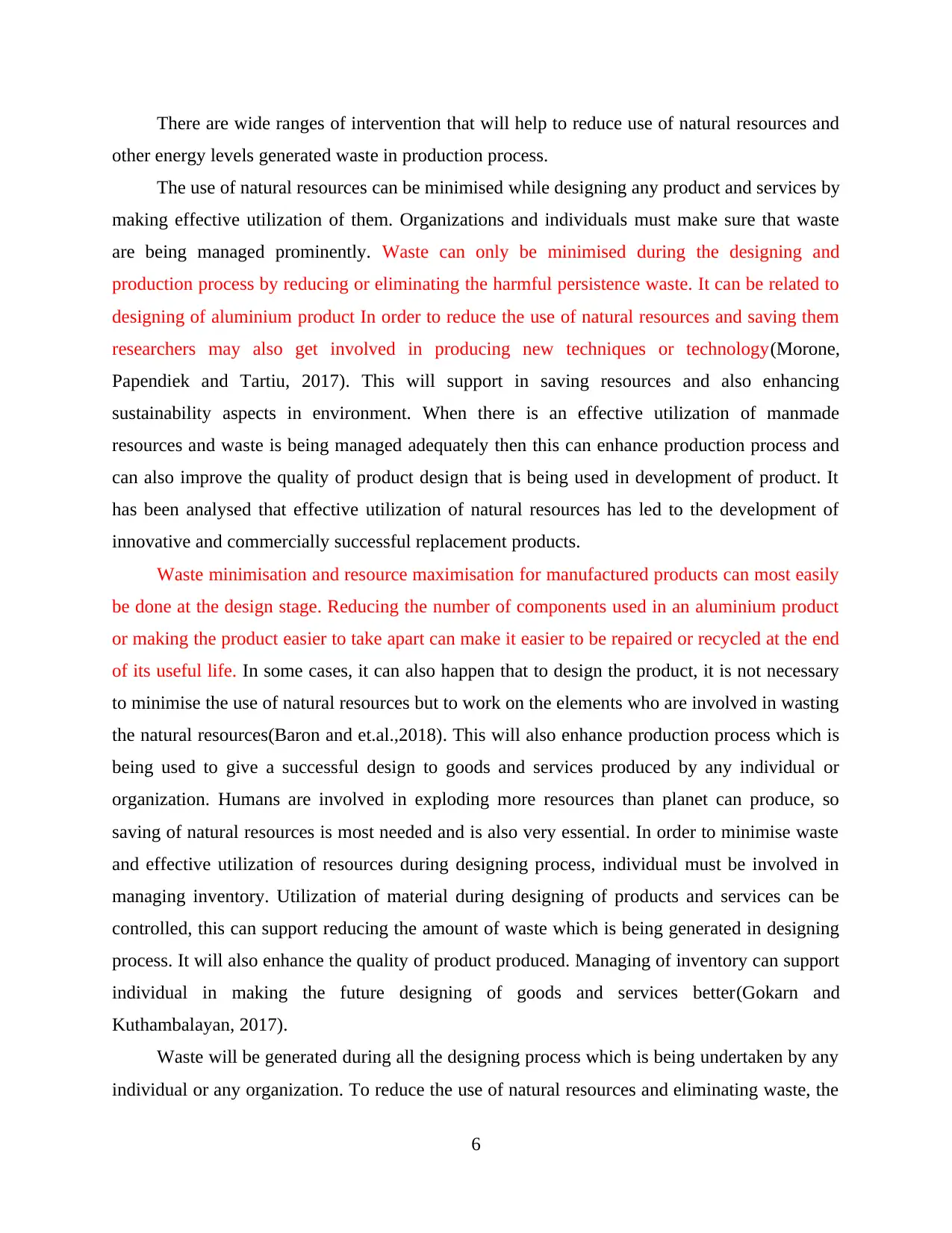
There are wide ranges of intervention that will help to reduce use of natural resources and
other energy levels generated waste in production process.
The use of natural resources can be minimised while designing any product and services by
making effective utilization of them. Organizations and individuals must make sure that waste
are being managed prominently. Waste can only be minimised during the designing and
production process by reducing or eliminating the harmful persistence waste. It can be related to
designing of aluminium product In order to reduce the use of natural resources and saving them
researchers may also get involved in producing new techniques or technology(Morone,
Papendiek and Tartiu, 2017). This will support in saving resources and also enhancing
sustainability aspects in environment. When there is an effective utilization of manmade
resources and waste is being managed adequately then this can enhance production process and
can also improve the quality of product design that is being used in development of product. It
has been analysed that effective utilization of natural resources has led to the development of
innovative and commercially successful replacement products.
Waste minimisation and resource maximisation for manufactured products can most easily
be done at the design stage. Reducing the number of components used in an aluminium product
or making the product easier to take apart can make it easier to be repaired or recycled at the end
of its useful life. In some cases, it can also happen that to design the product, it is not necessary
to minimise the use of natural resources but to work on the elements who are involved in wasting
the natural resources(Baron and et.al.,2018). This will also enhance production process which is
being used to give a successful design to goods and services produced by any individual or
organization. Humans are involved in exploding more resources than planet can produce, so
saving of natural resources is most needed and is also very essential. In order to minimise waste
and effective utilization of resources during designing process, individual must be involved in
managing inventory. Utilization of material during designing of products and services can be
controlled, this can support reducing the amount of waste which is being generated in designing
process. It will also enhance the quality of product produced. Managing of inventory can support
individual in making the future designing of goods and services better(Gokarn and
Kuthambalayan, 2017).
Waste will be generated during all the designing process which is being undertaken by any
individual or any organization. To reduce the use of natural resources and eliminating waste, the
6
other energy levels generated waste in production process.
The use of natural resources can be minimised while designing any product and services by
making effective utilization of them. Organizations and individuals must make sure that waste
are being managed prominently. Waste can only be minimised during the designing and
production process by reducing or eliminating the harmful persistence waste. It can be related to
designing of aluminium product In order to reduce the use of natural resources and saving them
researchers may also get involved in producing new techniques or technology(Morone,
Papendiek and Tartiu, 2017). This will support in saving resources and also enhancing
sustainability aspects in environment. When there is an effective utilization of manmade
resources and waste is being managed adequately then this can enhance production process and
can also improve the quality of product design that is being used in development of product. It
has been analysed that effective utilization of natural resources has led to the development of
innovative and commercially successful replacement products.
Waste minimisation and resource maximisation for manufactured products can most easily
be done at the design stage. Reducing the number of components used in an aluminium product
or making the product easier to take apart can make it easier to be repaired or recycled at the end
of its useful life. In some cases, it can also happen that to design the product, it is not necessary
to minimise the use of natural resources but to work on the elements who are involved in wasting
the natural resources(Baron and et.al.,2018). This will also enhance production process which is
being used to give a successful design to goods and services produced by any individual or
organization. Humans are involved in exploding more resources than planet can produce, so
saving of natural resources is most needed and is also very essential. In order to minimise waste
and effective utilization of resources during designing process, individual must be involved in
managing inventory. Utilization of material during designing of products and services can be
controlled, this can support reducing the amount of waste which is being generated in designing
process. It will also enhance the quality of product produced. Managing of inventory can support
individual in making the future designing of goods and services better(Gokarn and
Kuthambalayan, 2017).
Waste will be generated during all the designing process which is being undertaken by any
individual or any organization. To reduce the use of natural resources and eliminating waste, the
6
⊘ This is a preview!⊘
Do you want full access?
Subscribe today to unlock all pages.

Trusted by 1+ million students worldwide
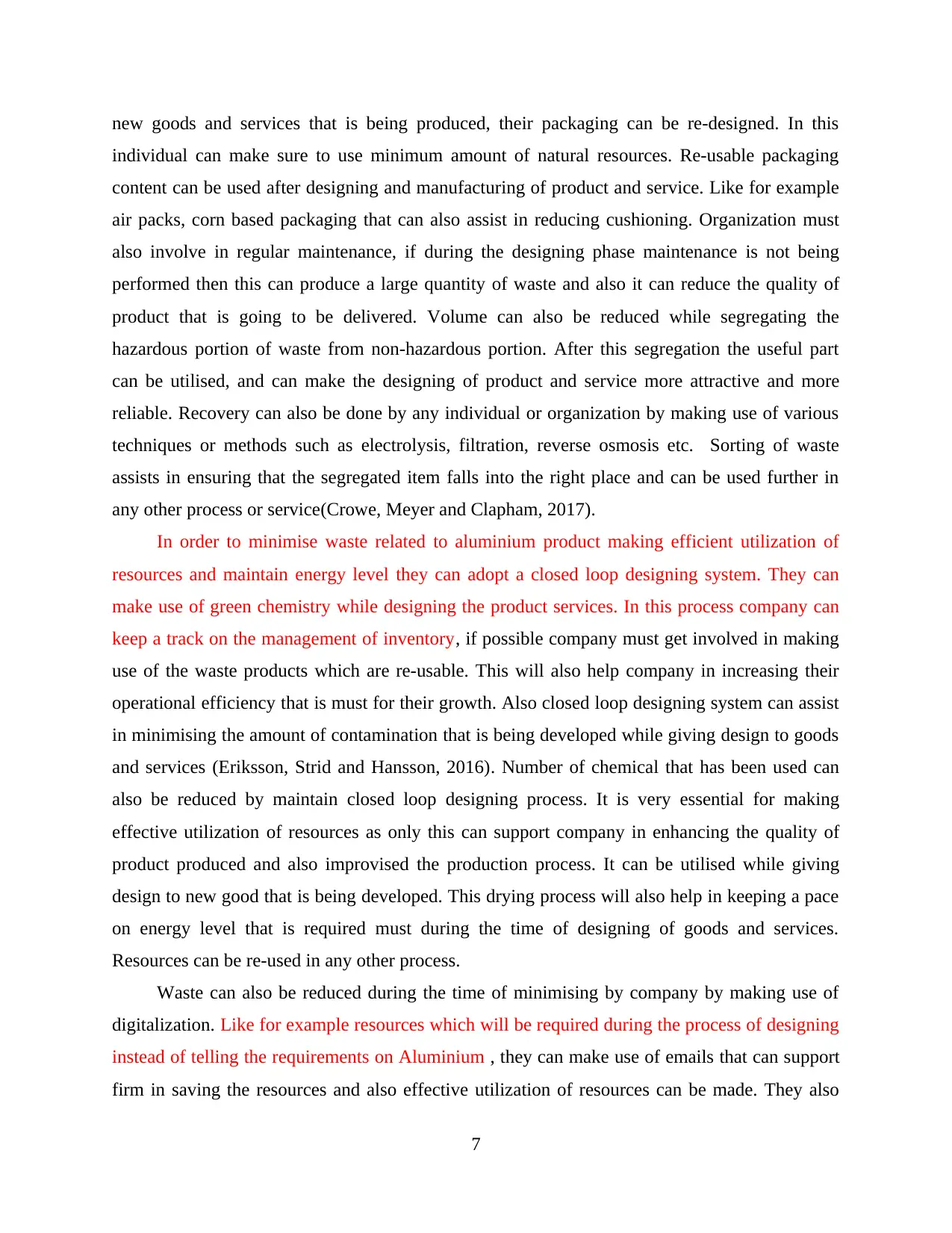
new goods and services that is being produced, their packaging can be re-designed. In this
individual can make sure to use minimum amount of natural resources. Re-usable packaging
content can be used after designing and manufacturing of product and service. Like for example
air packs, corn based packaging that can also assist in reducing cushioning. Organization must
also involve in regular maintenance, if during the designing phase maintenance is not being
performed then this can produce a large quantity of waste and also it can reduce the quality of
product that is going to be delivered. Volume can also be reduced while segregating the
hazardous portion of waste from non-hazardous portion. After this segregation the useful part
can be utilised, and can make the designing of product and service more attractive and more
reliable. Recovery can also be done by any individual or organization by making use of various
techniques or methods such as electrolysis, filtration, reverse osmosis etc. Sorting of waste
assists in ensuring that the segregated item falls into the right place and can be used further in
any other process or service(Crowe, Meyer and Clapham, 2017).
In order to minimise waste related to aluminium product making efficient utilization of
resources and maintain energy level they can adopt a closed loop designing system. They can
make use of green chemistry while designing the product services. In this process company can
keep a track on the management of inventory, if possible company must get involved in making
use of the waste products which are re-usable. This will also help company in increasing their
operational efficiency that is must for their growth. Also closed loop designing system can assist
in minimising the amount of contamination that is being developed while giving design to goods
and services (Eriksson, Strid and Hansson, 2016). Number of chemical that has been used can
also be reduced by maintain closed loop designing process. It is very essential for making
effective utilization of resources as only this can support company in enhancing the quality of
product produced and also improvised the production process. It can be utilised while giving
design to new good that is being developed. This drying process will also help in keeping a pace
on energy level that is required must during the time of designing of goods and services.
Resources can be re-used in any other process.
Waste can also be reduced during the time of minimising by company by making use of
digitalization. Like for example resources which will be required during the process of designing
instead of telling the requirements on Aluminium , they can make use of emails that can support
firm in saving the resources and also effective utilization of resources can be made. They also
7
individual can make sure to use minimum amount of natural resources. Re-usable packaging
content can be used after designing and manufacturing of product and service. Like for example
air packs, corn based packaging that can also assist in reducing cushioning. Organization must
also involve in regular maintenance, if during the designing phase maintenance is not being
performed then this can produce a large quantity of waste and also it can reduce the quality of
product that is going to be delivered. Volume can also be reduced while segregating the
hazardous portion of waste from non-hazardous portion. After this segregation the useful part
can be utilised, and can make the designing of product and service more attractive and more
reliable. Recovery can also be done by any individual or organization by making use of various
techniques or methods such as electrolysis, filtration, reverse osmosis etc. Sorting of waste
assists in ensuring that the segregated item falls into the right place and can be used further in
any other process or service(Crowe, Meyer and Clapham, 2017).
In order to minimise waste related to aluminium product making efficient utilization of
resources and maintain energy level they can adopt a closed loop designing system. They can
make use of green chemistry while designing the product services. In this process company can
keep a track on the management of inventory, if possible company must get involved in making
use of the waste products which are re-usable. This will also help company in increasing their
operational efficiency that is must for their growth. Also closed loop designing system can assist
in minimising the amount of contamination that is being developed while giving design to goods
and services (Eriksson, Strid and Hansson, 2016). Number of chemical that has been used can
also be reduced by maintain closed loop designing process. It is very essential for making
effective utilization of resources as only this can support company in enhancing the quality of
product produced and also improvised the production process. It can be utilised while giving
design to new good that is being developed. This drying process will also help in keeping a pace
on energy level that is required must during the time of designing of goods and services.
Resources can be re-used in any other process.
Waste can also be reduced during the time of minimising by company by making use of
digitalization. Like for example resources which will be required during the process of designing
instead of telling the requirements on Aluminium , they can make use of emails that can support
firm in saving the resources and also effective utilization of resources can be made. They also
7
Paraphrase This Document
Need a fresh take? Get an instant paraphrase of this document with our AI Paraphraser

need to track waste, if in designing process waste is not being track by firm then they will not be
able to know about what resources is being used and where. So they must keep a track. Waste
minimisation in any organization can support them in increasing productivity, it can also assist
them in boosting their sales that ultimately enhances profitability aspect of firm. Utilising
resources effectively can also help in reducing operational cost, by this firm can engage in
investing in better opportunities.
Summarise set of design recommendations
Aluminium is the excellent, environmentally friendly materials that can be recycled. Using
these materials, manufacturing companies can recycle excess metals, thereby reducing the
amount of waste they create. When company are involved in designing product and service, they
must have engaged in analysing and forecasting the resources that will be needed while
providing structure to the goods and services (Fercoq, Lamouri and Carbone, 2016)
It is mainly involved for developing strategy so that waste in designing process can be
managed effectively. This can support firm in their growth and also effective utilization of
resources can be made by it. They must also be involved in using that material during designing
process which can be reused and recycled. When Aluminium materials are being re-used then
they can reduce the burden which current environment is facing. Designers must be involved in
focusing on that strategy that supports in efficient utilization of material that is being used at the
time of developing goods and services. They must understand that how their choices of design
can affect the use of resources. They must make those choices in which resources are being used
adequately. It can also help in growth of company and they will increase their operational
productivity.
8
able to know about what resources is being used and where. So they must keep a track. Waste
minimisation in any organization can support them in increasing productivity, it can also assist
them in boosting their sales that ultimately enhances profitability aspect of firm. Utilising
resources effectively can also help in reducing operational cost, by this firm can engage in
investing in better opportunities.
Summarise set of design recommendations
Aluminium is the excellent, environmentally friendly materials that can be recycled. Using
these materials, manufacturing companies can recycle excess metals, thereby reducing the
amount of waste they create. When company are involved in designing product and service, they
must have engaged in analysing and forecasting the resources that will be needed while
providing structure to the goods and services (Fercoq, Lamouri and Carbone, 2016)
It is mainly involved for developing strategy so that waste in designing process can be
managed effectively. This can support firm in their growth and also effective utilization of
resources can be made by it. They must also be involved in using that material during designing
process which can be reused and recycled. When Aluminium materials are being re-used then
they can reduce the burden which current environment is facing. Designers must be involved in
focusing on that strategy that supports in efficient utilization of material that is being used at the
time of developing goods and services. They must understand that how their choices of design
can affect the use of resources. They must make those choices in which resources are being used
adequately. It can also help in growth of company and they will increase their operational
productivity.
8

CONCLUSION
In above discussion, it concluded that Resource efficient design is defined as a process that
mainly used for supplying raw materials for designing an effective product. it also performed
various function for reducing waste resources expenses. It has summarised about the resource’s
considerations that applicable in product development and their design pattern. In above analysis,
it can be determined to set up specific criteria in production process for reducing waste of energy
resources. Furthermore, it has evaluated the production process which may outline set of design
recommendation for improving efficiency and performance. However, the report has described
about various natural resources that useful in process life cycle and also identifying the
interventions for minimizing the use of natural resources, energy level of waste generated in
production process.
9
In above discussion, it concluded that Resource efficient design is defined as a process that
mainly used for supplying raw materials for designing an effective product. it also performed
various function for reducing waste resources expenses. It has summarised about the resource’s
considerations that applicable in product development and their design pattern. In above analysis,
it can be determined to set up specific criteria in production process for reducing waste of energy
resources. Furthermore, it has evaluated the production process which may outline set of design
recommendation for improving efficiency and performance. However, the report has described
about various natural resources that useful in process life cycle and also identifying the
interventions for minimizing the use of natural resources, energy level of waste generated in
production process.
9
⊘ This is a preview!⊘
Do you want full access?
Subscribe today to unlock all pages.

Trusted by 1+ million students worldwide
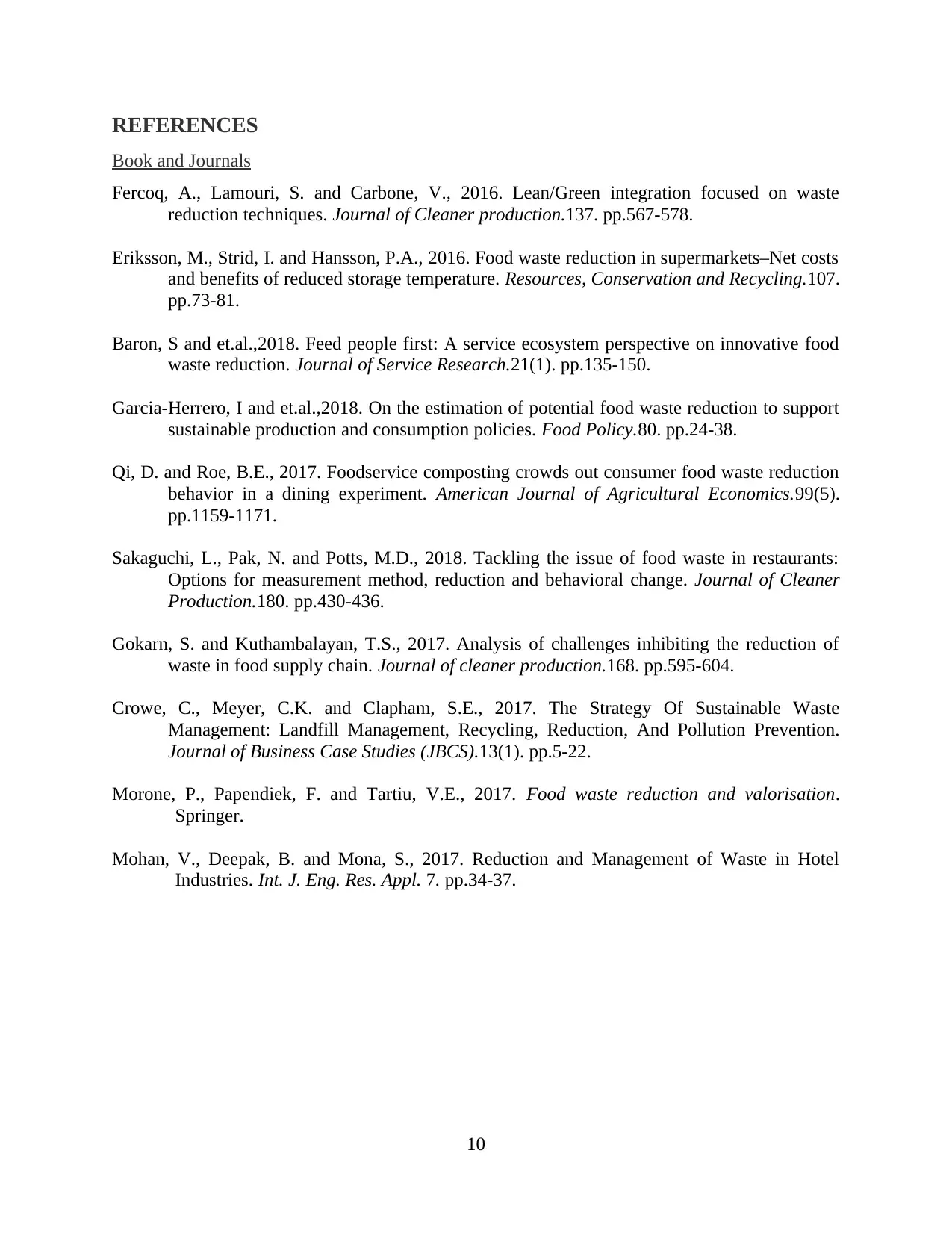
REFERENCES
Book and Journals
Fercoq, A., Lamouri, S. and Carbone, V., 2016. Lean/Green integration focused on waste
reduction techniques. Journal of Cleaner production.137. pp.567-578.
Eriksson, M., Strid, I. and Hansson, P.A., 2016. Food waste reduction in supermarkets–Net costs
and benefits of reduced storage temperature. Resources, Conservation and Recycling.107.
pp.73-81.
Baron, S and et.al.,2018. Feed people first: A service ecosystem perspective on innovative food
waste reduction. Journal of Service Research.21(1). pp.135-150.
Garcia-Herrero, I and et.al.,2018. On the estimation of potential food waste reduction to support
sustainable production and consumption policies. Food Policy.80. pp.24-38.
Qi, D. and Roe, B.E., 2017. Foodservice composting crowds out consumer food waste reduction
behavior in a dining experiment. American Journal of Agricultural Economics.99(5).
pp.1159-1171.
Sakaguchi, L., Pak, N. and Potts, M.D., 2018. Tackling the issue of food waste in restaurants:
Options for measurement method, reduction and behavioral change. Journal of Cleaner
Production.180. pp.430-436.
Gokarn, S. and Kuthambalayan, T.S., 2017. Analysis of challenges inhibiting the reduction of
waste in food supply chain. Journal of cleaner production.168. pp.595-604.
Crowe, C., Meyer, C.K. and Clapham, S.E., 2017. The Strategy Of Sustainable Waste
Management: Landfill Management, Recycling, Reduction, And Pollution Prevention.
Journal of Business Case Studies (JBCS).13(1). pp.5-22.
Morone, P., Papendiek, F. and Tartiu, V.E., 2017. Food waste reduction and valorisation.
Springer.
Mohan, V., Deepak, B. and Mona, S., 2017. Reduction and Management of Waste in Hotel
Industries. Int. J. Eng. Res. Appl. 7. pp.34-37.
10
Book and Journals
Fercoq, A., Lamouri, S. and Carbone, V., 2016. Lean/Green integration focused on waste
reduction techniques. Journal of Cleaner production.137. pp.567-578.
Eriksson, M., Strid, I. and Hansson, P.A., 2016. Food waste reduction in supermarkets–Net costs
and benefits of reduced storage temperature. Resources, Conservation and Recycling.107.
pp.73-81.
Baron, S and et.al.,2018. Feed people first: A service ecosystem perspective on innovative food
waste reduction. Journal of Service Research.21(1). pp.135-150.
Garcia-Herrero, I and et.al.,2018. On the estimation of potential food waste reduction to support
sustainable production and consumption policies. Food Policy.80. pp.24-38.
Qi, D. and Roe, B.E., 2017. Foodservice composting crowds out consumer food waste reduction
behavior in a dining experiment. American Journal of Agricultural Economics.99(5).
pp.1159-1171.
Sakaguchi, L., Pak, N. and Potts, M.D., 2018. Tackling the issue of food waste in restaurants:
Options for measurement method, reduction and behavioral change. Journal of Cleaner
Production.180. pp.430-436.
Gokarn, S. and Kuthambalayan, T.S., 2017. Analysis of challenges inhibiting the reduction of
waste in food supply chain. Journal of cleaner production.168. pp.595-604.
Crowe, C., Meyer, C.K. and Clapham, S.E., 2017. The Strategy Of Sustainable Waste
Management: Landfill Management, Recycling, Reduction, And Pollution Prevention.
Journal of Business Case Studies (JBCS).13(1). pp.5-22.
Morone, P., Papendiek, F. and Tartiu, V.E., 2017. Food waste reduction and valorisation.
Springer.
Mohan, V., Deepak, B. and Mona, S., 2017. Reduction and Management of Waste in Hotel
Industries. Int. J. Eng. Res. Appl. 7. pp.34-37.
10
1 out of 10
Related Documents
Your All-in-One AI-Powered Toolkit for Academic Success.
+13062052269
info@desklib.com
Available 24*7 on WhatsApp / Email
![[object Object]](/_next/static/media/star-bottom.7253800d.svg)
Unlock your academic potential
Copyright © 2020–2025 A2Z Services. All Rights Reserved. Developed and managed by ZUCOL.





